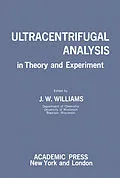Ultracentrifugal Analysis: In Theory and Experiment aims to tackle some outstanding problems in sedimentation analysis. The book presents topics such as the thermodynamics of diffusion and sedimentation; diffusion and sedimentation in multicomponent systems; and the frictional formalism in the flow equations of sedimentation. The text also includes topics such as solutions of the general differential equation for the ultracentrifuge; the interpolation diagram for calculating model Schlieren patterns for reversibly interacting systems; and sedimentation of reversibly aggregating substances. Articles on the effects of charge on the sedimentation, the diffusion and the sedimentation equilibrium of colloidal electrolytes; the basic equilibrium equations; and the sedimentation equilibrium in reacting systems are also considered. The book further tackles articles on the optical systems for sedimentation analysis; computational methods of ultracentrifugation; separation cells; and the magnetic bearing for an ultracentrifuge. Chemists, physicists, and biologists will find the book invaluable.
Inhalt
Participants in the Conference
The Aims of the Conference
Introductory Remarks
Part I Transport Theory
Thermodynamics of Diffusion and Sedimentation
I. Introduction
II. General Theory
III. Applications
References
Diffusion and Sedimentation in Multicomponent Systems
I. Introduction
II. Independently Moving Substances
III. Sedimentation Equilibrium
IV. Sedimentation Coefficients and Diffusion Coefficients
V. General Relation between Sedimentation and Diffusion
VI. Formulas for Two Substances
VII. Formulas for Three Substances
References
Frîctional Formalism in the Flow Equations of Sedimentation
I. Equivalence of the Lamm and Onsager Formulations
II. Flow Equations in Terms of Frictions
III. Component Transformations by Tensor Formalism
References
Solutions of the General Differential Equation for the Ultracentrifuge
I. Introduction
II. Simple Exact and Approximate Solutions
III. General Properties Suggesting Possible Experiments
References
Comments
Problems in the Determination of Molecular Weight Distributions by Sedimentation Transport
I. Introduction
II. Sedimentation in a -Solvent
III. Effects of Pressure on Sedimentation Coefficient
IV. Concentration Effects
V. Concentration Dependence of s in -Solvents
References
Comments
An Interpolation Diagram for Calculating Model Schlieren Patterns for Reversibly Interacting Systems
I. Introduction
II. Glossary
III. Relating Theory to Experiment
IV. Graphical Representation
V. Schlieren Pattern
VI. Example: Sedimentation of Pepsin and Albumin in Mixture
VII. Conclusion
References
Sedimentation of Reversibly Aggregating Substances
I. Introduction
II. Basic Postulates
III. Example
References
Comments
Effects of Charge on the Sedimentation, the Diffusion and the Sedimentation Equilibrium of Colloidal Electrolytes
I. Introduction
II. General Equations
III. Sedimentation Equilibrium, Sedimentation, and Diffusion
IV. The Quantities Derived from Experimental Diagrams
V. A Model of the Solution
VI. Final Equations for the Molecular Weight
VII. The Primary Charge Effect
References
Part II Eqiulibrium Theory
Basic Equilibrium Theory
I. Introduction
II. General Equations
III. Two-Component Systems
IV. Three-Component Systems
V. Polycomponent Systems
Comments
Sedimentation Equilibrium in Reacting Systems
I. Introduction
II. Theory
III. Discussion
References
Comments
The Transient State in Density-Gradient Centrifugation
I. The Continuity Equation for the Problem
II. The Equilibrium Distribution
III. The Transient Distribution
IV. Moments of the Transient Distribution
V. Possible Applications
VI. Effects of Density Heterogeneity
VII. Significance of the Quantity ó2/Æ)
VIII. Comparison with Experiment
References
Measurement of Density Heterogeneity by Sedimentation in Preformed Gradients
I. Introduction
II. The Time Needed for Sedimentation to Equilibrium in a Preformed Density Gradient
III. Duration of a Nonequilibrium Density Gradient
IV. Results and Computations
V. Appendix
References
Comments
Part III Practice
Optical Systems for Sedimentation Analysis
I. Introduction
II. General Comments
III. An Automatic, Direct-Recording, Photoelectric-Scanning Absorption Optical System
References
Computational Methods of Ultracentrifugation
I. Introduction
II. Minimum Apparent s-Rate in Preparative Ultracentrifugation
III. Geometrical Complications
IV. Moment Method of Computation
V. Computational Process
VI. Summary
References
Separation Cells
I. Introduction
II. Separation Cells
III. Characterization of Solutes
IV. Summary
References
Magnetic Bearing for an Ultracentrifuge
I. Introduction
II. Suspension of the Rotor
III. The Characteristic Equation of the System
IV. Details of the System
V. Alignment and Operation
VI. Summary
References
Comments
A Survey of the Uses of the Ultracentrifuge in Biological Research
I. General Considerations
II. Uses of the Ultracentrifuge
III. Conclusions
References
Author Index
Subject Index
